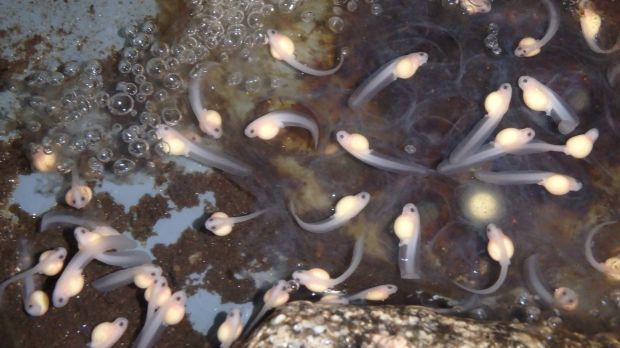To the uninitiated they don't look like much to get excited about. Perhaps the only intriguing thing is that their bulbous bodies are a milky white, rather than dark brown or black. But these tadpoles are special.
They are the first Baw Baw frog tadpoles to have been bred in captivity. And they started hatching at Melbourne Zoo's dedicated "Baw Baw Bunker" in mid-December.
More Environment News Videos
Endangered Baw Baw frog stuns zookeeper
The moment amphibian expert Deon Gilbert discovered a pregnant female Baw Baw frog frog high upon a muddy mountaintop in October. Only found on the Mount Baw Baw plateau, the frogs are in such a perilous position it has been estimated they may be extinct in the wild within five years. (Video courtesy: Zoos Victoria)
The milestone comes after 11 females were captured last October from their home on the Mount Baw Baw plateau, 120 kilometres east of Melbourne. It was the first time in six years of looking that researchers had found the elusive wild females, which live underground and don't croak, making them impossible to locate.
Until then, the zoo's Baw Baw frog captive breeding program operated without females. Researchers trying to build up an insurance population for the critically endangered species had to rely on collecting fertilised eggs from the wild and hatching them at the zoo.
These tadpoles represent a change in the threatened frogs' prospects. After being on a downward trajectory since the mid-1980s due to a highly contagious waterborne disease called chytrid fungus, things are finally looking up for the rare alpine frog.
Keepers estimate they will be able to raise about 30 baby Baw Baw frogs this year from the 11 pioneer females.
While 90 per cent of the eggs laid by the females were infertile, the tadpole success rate is much higher. Between 80 per cent and 100 per cent will get through.
Melbourne Zoo amphibian specialist Damian Goodall said the low fertility rate for the eggs was most likely due to the females being moved from the wild to captivity during their breeding season.

"In the next breeding season the females will be fitter and more acclimatised to their new environment," he said.
The tadpoles are being raised in complete darkness because they are light-sensitive - which is why they are white.

When the tadpoles mature and become frogs they will start a high-calcium diet of insects such as crickets, springtails and slaters. However, it will be five years before this trailblazing generation is ready to start breeding.
In the meantime, scientists are learning about the frogs' diet; what makes males start their mating calls and what conditions prompt them to build a nest in the mud for the females.

"We're still pioneering all the husbandry techniques," Mr Goodall said. "We've got a pretty good handle on it but like anything, there's always more to learn, especially with alpine species."
It's a significant turnaround for the frog. Its species' wild population had dropped to such critically low levels, it was estimated that Baw Baw frogs could be extinct in the wild within five years.

Mr Goodall said finding the females was a huge leap for the critically endangered species, putting the recovery program ahead by about four years.
















